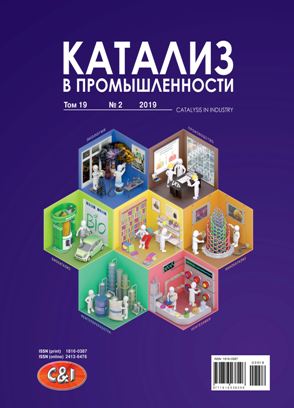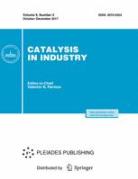
«Kataliz v promyshlennosti» (Catalysis in Industry) journal has been established by "Kalvis" Close Joint-Stock Company in the year of 2001 and registered in the RF Ministry of Press, Television and Radio Broadcasting (mass media registration certificate ПИ № 77-7794 dated April 30, 2001), number of international registration ISSN 1816-0387. Circulation: 150 copies. Number volume: 80 pages (10 printed sheets).
Since 2009, PLEIADES PUBLISHING, LTD has published and the Springer Publishing House has dispersed the English-language version of the “Catalysis in Industry” journal. The journal is dispersed in the Russian Federation and the CIS countries.
«Kataliz v promyshlennosti» (Catalysis in Industry) is a peer reviewed journal that covers the following topical areas: production and use of catalysts for various branches of industry; catalytic processes and theoretical foundations of industrial catalysis and technologies; advances in catalysis; and history of the development of industrial catalysis. The journal publishes reviews and original articles and welcomes manuscripts from all countries in the English or Russian language.
The journal «Catalysis in Industry» is included in the international database of SCOPUS, indexed in the Web of Science Emerging Sources Citation Index.
The place in the SCIENCE INDEX rating for 2020 on the topic "Chemical technology, the chemical industry" – 1, on the subject "Chemistry" - 13. The two-year impact factor of RINC including the english-language version as of 2020 is 1,441. The five-year impact factor of RINC is 1,278 (the information from the site: http://elibrary.ru/title_profile.asp? id=7328).
Sections of the journal:
- General problems of catalysis
- Physico-chemical methods in catalysis
- Catalysis and nanotechnology
- Catalysis in chemical and petrochemical industry
- Catalysis in petroleum refining industry
- Catalysis and environmental protection
- Industry engineering problems. Operation and production.
- Domestic catalysts
- Biocatalysis
- Photo- and electrocatalysis
- History of catalysis
Current issue
GENERAL PROBLEMS OF CATALYSIS
CATALYSIS IN CHEMICAL AND PETROCHEMICAL INDUSTRY
СATALYSIS AND ENVIRONMENT PROTECTION
Announcements
2025-07-28
Российский нефтегазовый технический конгресс пройдет в Москве
8 – 10 октября 2025 в отеле Лесная Сафмар в Москве уже в 4-й раз соберутся представители ведущих компаний, чтобы обсудить современные принципы и технологии в нефтегазовом комплексе РФ и мира.
2025-07-28
Конференция и выставка по малотоннажной, среднетоннажной и крупнотоннажной химии и сингазу «РАЗНОТОННАЖНАЯ ХИМИЯ 2025»
Конференция и выставка по малотоннажной, среднетоннажной и крупнотоннажной химии и сингазу «РАЗНОТОННАЖНАЯ ХИМИЯ 2025» состоится 2 – 3 сентября 2025 года в г. Москва, Hotel Continental.
2025-07-02
Конференция и выставка по малотоннажной, среднетоннажной и крупнотоннажной химии и сингазу «РАЗНОТОННАЖНАЯ ХИМИЯ 2025»
Конференция и выставка по малотоннажной, среднетоннажной и крупнотоннажной химии и сингазу «РАЗНОТОННАЖНАЯ ХИМИЯ 2025» состоится 2 – 3 сентября 2025 года в г. Москва, Hotel Continental. Организатором мероприятия выступает компания Energy Leader.
2025-07-02
Конференция и выставка по развитию портовой инфраструктуры и терминалов «ТЕРМИНАЛЫ 2025»
Конференция и выставка по развитию портовой инфраструктуры и терминалов «ТЕРМИНАЛЫ 2025» состоится 4 сентября 2025 года в г. Москва, Hotel Continental. Организатор мероприятия – компания Energy Leader.
2025-07-02
Конференция и выставка по развитию портовой инфраструктуры и терминалов «ТЕРМИНАЛЫ 2025»
Конференция и выставка по развитию портовой инфраструктуры и терминалов «ТЕРМИНАЛЫ 2025» состоится 4 сентября 2025 года в г. Москва, Hotel Continental. Организатор мероприятия – компания Energy Leader.
| More Announcements... |
























